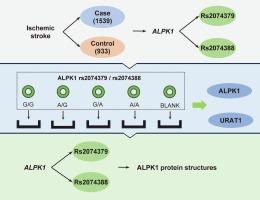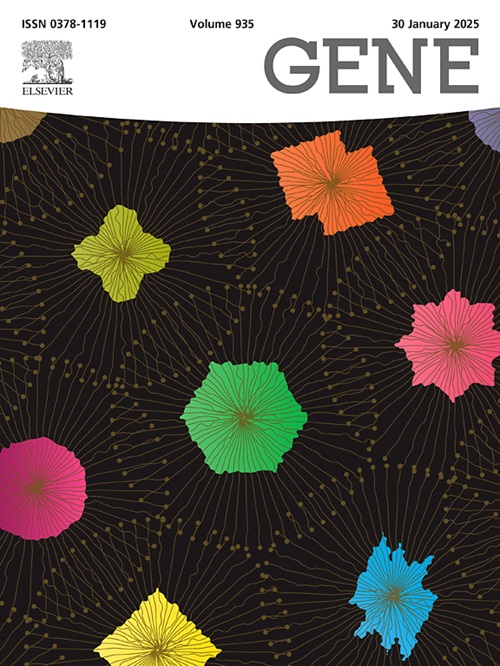通过抑制尿酸止血过程中的 URAT1,发现缺血性中风易感性与 ALPK1 单核苷酸多态性有关。
IF 2.6
3区 生物学
Q2 GENETICS & HEREDITY
引用次数: 0
摘要
目的:缺血性脑卒中(IS)发病率逐年上升,发现非干预性遗传影响因素的必要性也在不断提高。单核苷酸多态性(SNP)在疾病易感性的稳定遗传中起着关键作用。基于α-激酶1(ALPK1)与传统的IS风险因素尤其是高尿酸血症之间的关系,我们的研究探讨了ALPK1 SNPs与IS易感性的关联和功能:方法:我们对中国东北地区的 1539 例患者和 933 例对照进行了病例对照研究。收集了 ALPK1 rs2074379 和 rs2074388 的基因分型信息。将 rs2074379/rs2074388 G/G、A/G、G/A 和 A/A 四种质粒转染至 293T 细胞,观察 ALPK1 和 SLC22A12 的表达。在线预测了不同SNP的ALPK1可能的结构:结果:发现rs2074379的基因型GG(OR = 1.371,CI = 1.029-1.828,P = 0.031)和GA(OR = 1.326,CI = 1.110-1.584,P = 0.002)以及rs2074388的基因型GA(OR = 1.359,CI = 1.137-1.624,P = 0.001)显著易感于IS,位点上的G等位基因是风险等位基因。Rs2074379 与高尿酸血症有乘法交互作用(OR = 1.637,CI = 1.157-2.315,P = 0.005)。尿酸水平在基因型中存在差异(P 结论:ALPK1 rs2074379 与高尿酸血症有多重交互作用:ALPK1 rs2074379和rs2074388 SNP与IS易感性有功能相关性。野生等位基因可能通过降低ALPK1表达和抑制URAT1提高尿酸水平来增加IS风险,有助于进一步探索脑卒中的发病机制。中国临床试验注册号:ChiCTR-COC-1701ChiCTR-COC-17013559。本文章由计算机程序翻译,如有差异,请以英文原文为准。

Ischemic stroke susceptibility associated with ALPK1 single nucleotide polymorphisms by inhibiting URAT1 in uric acid hemostasis
Objectives
Ischemic stroke (IS) prevalence rising annually, the necessity of discovering non-interventional genetic influences is progressing. Single nucleotide polymorphism (SNP) plays a pivotal role in stable inheritance of disease susceptibility. Based on the relationship between Alpha- Kinase 1 (ALPK1) and traditional IS risk factors especially hyperuricemia, our study investigated the association and function of ALPK1 SNPs with IS susceptibility.
Methods
A case-control study of 1539 patients and 933 controls from northeast China was conducted. Genotyping information of ALPK1 rs2074379 and rs2074388 was collected. Four types of plasmids including rs2074379/rs2074388 G/G, A/G, G/A, and A/A were transfected into 293T cells to observe ALPK1 and SLC22A12 expression. Possible ALPK1 structures of different SNPs were predicted online.
Results
Genotype GG (OR = 1.371, CI = 1.029–1.828, P = 0.031) and GA (OR = 1.326, CI = 1.110–1.584, P = 0.002) of rs2074379 and GA of rs2074388 (OR = 1.359, CI = 1.137–1.624, P = 0.001) were found significantly susceptible to IS, with G allele on sites to be a risk allele. Rs2074379 had a multiplicative interaction with hyperuricemia (OR = 1.637, CI = 1.157–2.315, P = 0.005). Uric acid levels differed in genotypes (P < 0.001). The expression of ALPK1 (P < 0.01) and SLC22A12 in membrane urate transporter 1 (URAT1) protein (P < 0.05) functionally changed with G allele on either site. With glycine changing into aspartic acid at rs2074388, the protein secondary structure changed, but the ALPK1 protein subtype remained still.
Conclusions
ALPK1 rs2074379 and rs2074388 SNPs were functionally associated with IS susceptibility. The wild allele progressed IS risk probably by reducing ALPK1 expression and inhibiting URAT1 raising the uric acid level, contributing to further exploration of pathogenetic mechanisms of stroke.
Chinese Clinical Trial Registration number: ChiCTR-COC-17013559.
求助全文
通过发布文献求助,成功后即可免费获取论文全文。
去求助
来源期刊

Gene
生物-遗传学
CiteScore
6.10
自引率
2.90%
发文量
718
审稿时长
42 days
期刊介绍:
Gene publishes papers that focus on the regulation, expression, function and evolution of genes in all biological contexts, including all prokaryotic and eukaryotic organisms, as well as viruses.
 求助内容:
求助内容: 应助结果提醒方式:
应助结果提醒方式:


